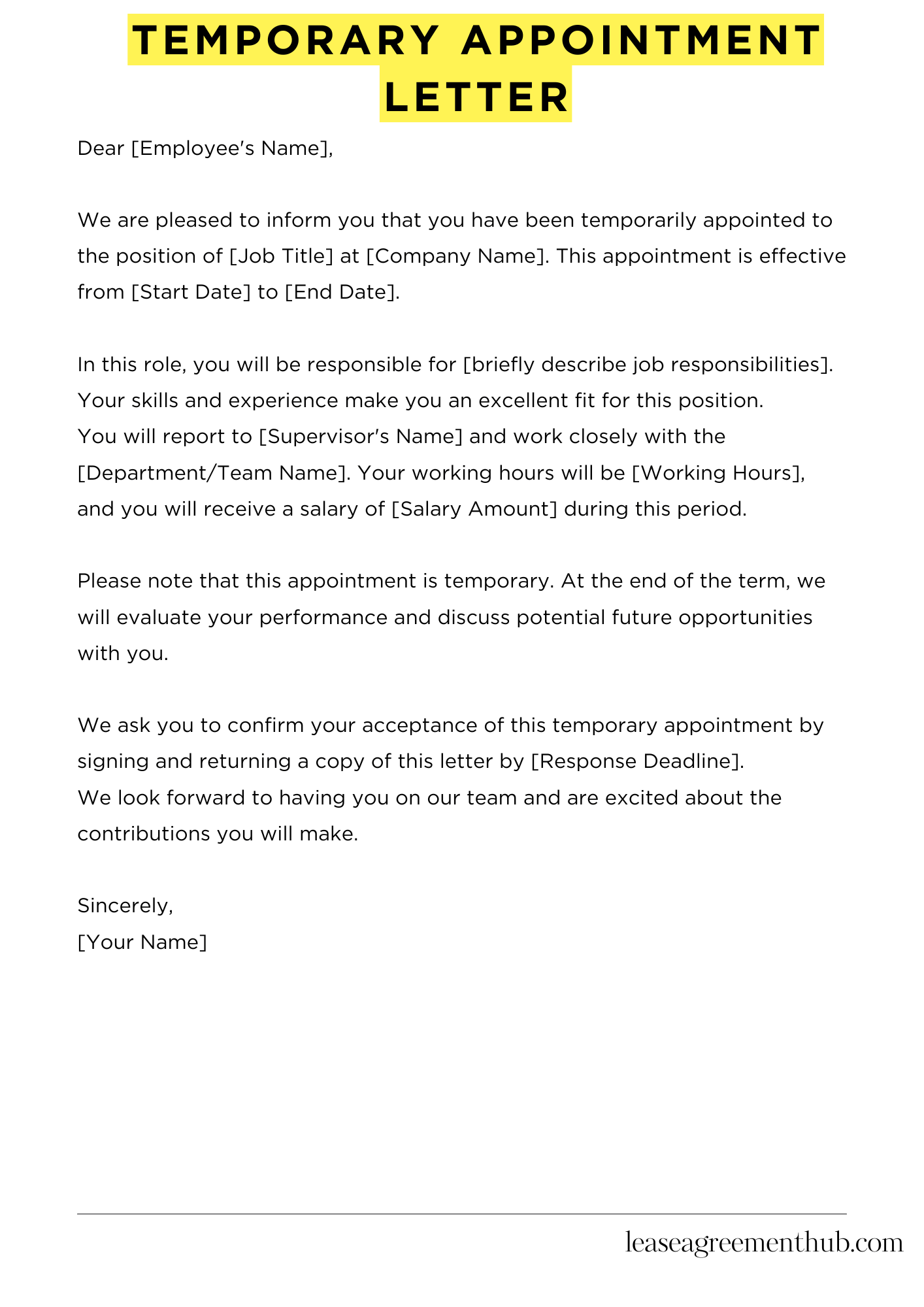A Temporary Appointment Letter is a formal document used by employers to confirm a short-term job assignment for an employee. Its purpose is to outline the terms of the temporary position, including job responsibilities, duration, and any specific conditions. This letter serves as a clear communication tool between the employer and the employee.
In this article, we will provide various templates and examples of Temporary Appointment Letters. These samples are designed to help you easily create your own letter. Whether you need a letter for a specific role or a general template, we have you covered.
Our goal is to make the process of writing a Temporary Appointment Letter straightforward and efficient. You can customize these examples to fit your needs. This will save you time and ensure that your letter is professional and effective.
Temporary Appointment Letter
[Your Company Name]
[Your Company Address]
[City, State, Zip Code]
[Email Address]
[Phone Number]
[Date]
[Employee’s Name]
[Employee’s Address]
[City, State, Zip Code]
Dear [Employee’s Name],
We are pleased to inform you that you have been temporarily appointed to the position of [Job Title] at [Company Name]. This appointment is effective from [Start Date] to [End Date].
In this role, you will be responsible for [briefly describe job responsibilities]. Your skills and experience make you an excellent fit for this position.
You will report to [Supervisor’s Name] and work closely with the [Department/Team Name]. Your working hours will be [Working Hours], and you will receive a salary of [Salary Amount] during this period.
Please note that this appointment is temporary. At the end of the term, we will evaluate your performance and discuss potential future opportunities with you.
We ask you to confirm your acceptance of this temporary appointment by signing and returning a copy of this letter by [Response Deadline].
We look forward to having you on our team and are excited about the contributions you will make.
Sincerely,
[Your Name]

How to Write Temporary Appointment Letter
Understanding the Purpose of a Temporary Appointment Letter
A temporary appointment letter is a formal document that confirms the hiring of an employee for a specific period. This letter outlines the terms of employment, including the duration, job responsibilities, and compensation. It serves as a legal record for both the employer and the employee. Knowing its purpose is crucial for writing an effective letter.
Key Components of the Letter
When crafting a temporary appointment letter, several key components should be included:
- Employer Information: Include the company name, address, and contact details.
- Employee Information: State the employee’s name, address, and position.
- Duration of Appointment: Clearly specify the start and end dates of the temporary position.
- Job Responsibilities: Outline the main duties the employee is expected to perform.
- Compensation: Mention the salary and any benefits the employee will receive.
Writing the Letter
Start with a formal greeting. Address the letter to the employee by their full name. Use a clear and professional tone throughout. Begin with a statement that confirms the appointment. For example, “We are pleased to offer you a temporary position as [Job Title].” Follow this with the details outlined in the previous section. Be concise but comprehensive. Ensure that the letter is easy to read and understand.
Reviewing the Letter
After writing the letter, take the time to review it carefully. Check for any spelling or grammatical errors. Ensure that all the information is accurate and complete. It may be helpful to have a colleague read it as well. A second set of eyes can catch mistakes you might have missed. This step is vital to maintain professionalism.
Delivering the Letter
Once the letter is finalized, it’s time to deliver it. You can send it via email or print a hard copy for a personal handover. If you choose to send it electronically, ensure that the format is professional. If handing it over in person, consider scheduling a brief meeting to discuss the role and answer any questions. This approach helps to foster a positive relationship from the start.
Related: